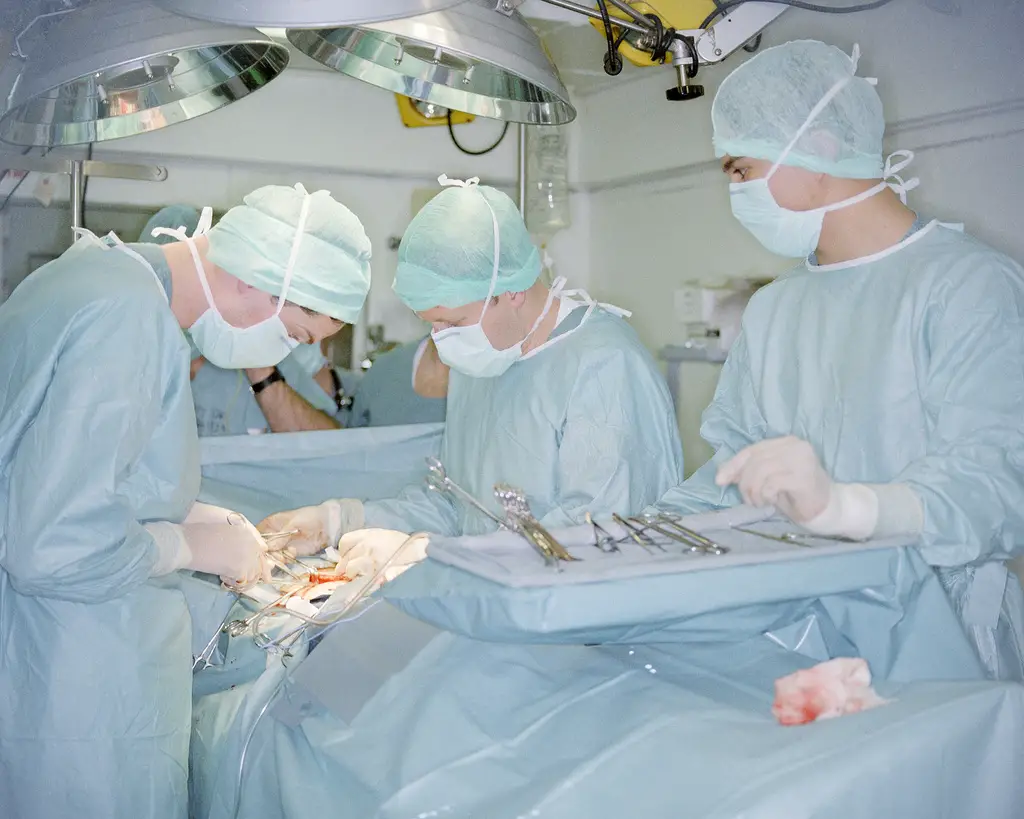What Do Surgeons Wear

Surgeons are medical professionals who specialize in the diagnosis and treatment of diseases, injuries, and other conditions through surgical procedures. As such, they are responsible for the safety of their patients and must take extra precautions when performing surgeries. To ensure the safety of their patients and themselves, surgeons must wear specialized clothing known as surgical scrubs. Surgical scrubs are designed to provide comfort, protect against infection, and provide a professional look. In this article, we will discuss what surgeons wear and why it is important.Surgeons typically wear scrubs while performing surgery. Scrubs are a type of uniform worn by medical professionals that consist of a short-sleeved shirt and pants. The fabric used for scrubs is usually a poly-cotton blend that is designed to be comfortable and easy to clean. In addition, surgeons also wear a protective face mask, surgical cap, and sterile gloves to help minimize the risk of infection.
What Do Surgeons Need to Wear in the Operating Room?
Surgeons are required to wear a variety of protective clothing when performing surgery in an operating room. This clothing helps protect surgeons and other personnel from infection, contamination, and other hazards that may be present in the operating environment. The type of clothing worn by a surgeon can vary depending on the procedure being performed. Generally, all surgeons must wear scrubs, a sterile gown, gloves, a face mask, and a surgical cap or hood.
Scrubs are loose-fitting garments made from cotton or polyester blend fabric. They are usually light blue or green in color and help create a sterile environment by providing protection against splashes or spills of bodily fluids during surgery. The scrubs also help keep the operating room clean by preventing dirt or debris from accidentally entering the sterile field.
A sterile gown is typically worn over the scrubs for extra protection against contaminants. The gowns are usually made of disposable fabric and must be changed between surgical procedures to maintain sterility. The surgeon may also choose to wear booties over their shoes for added protection and comfort while standing in the operating room for extended periods of time.
Gloves are essential for protecting both the patient and surgeon during surgery. Surgeons must wear sterile gloves that fit properly so they do not tear easily during surgery. Additionally, surgeons may opt to wear double gloves to reduce their risk of coming into contact with infectious material during procedures that involve high levels of contamination risk such as neurosurgery or trauma surgery.
A face mask is also necessary for preventing contamination during surgery. The mask should cover both the nose and mouth snugly to prevent droplets from escaping into the air around them while they operate on patients. It is important that any masks used by surgeons be changed between patients to ensure sterility is maintained throughout each procedure.
Finally, surgeons must also wear a surgical cap or hood when performing procedures in an operating room environment. This helps protect both the patient and surgeon from any bacteria that might be present in hair follicles on their head or scalp area while they operate on patients. It is important that all personnel in an operating room, including surgeons, wear clean hats or hoods at all times while performing surgeries so as not to spread any potential contaminants to different areas of the OR.
By wearing appropriate gear such as scrubs, gowns, gloves, face masks, and caps/hoods in an operating room setting, surgeons can help ensure a safe surgical environment free of contamination risks for both themselves and their patients alike
The Benefits of Wearing Scrubs in the Operating Room
Wearing scrubs in the operating room is essential for both patient and staff safety. Scrubs provide a barrier between the patient and the operating room staff to reduce the spread of infection. Scrubs also keep the operating room environment sterile by providing a barrier for contaminants that may be on the skin or clothing of medical personnel. Additionally, scrubs are comfortable and allow medical personnel to move freely while performing their duties.
Scrubs are typically made from lightweight, breathable fabric that is designed to keep personnel cool and comfortable during long procedures. They also come in a variety of colors and styles, making it easy to differentiate between medical personnel and other personnel in the operating room. Additionally, scrubs can be easily cleaned or replaced if they become contaminated or damaged. This helps to ensure a sterile environment for all patients.
Another benefit of wearing scrubs in the operating room is that they provide medical personnel with easy access to their equipment and supplies during procedures. Scrubs have pockets or compartments where supplies can be kept close at hand, allowing medical personnel to quickly access them when needed. This helps reduce time spent searching for items during surgery, which can help improve patient safety as well as efficiency in the operating room.
Finally, wearing scrubs can help create a professional atmosphere in an otherwise stressful environment. By establishing clear boundaries between medical staff and patients, scrubs help create an atmosphere of respect and professionalism that can ease tension before surgery begins. This helps to create an environment where patients feel safe and secure during their procedure.
In summary, wearing scrubs in the operating room has many benefits for both patients and medical personnel alike. They provide a barrier against infection, are comfortable, allow easy access to supplies, and help create a professional atmosphere. For these reasons, wearing scrubs is essential for any successful surgical procedure.
Why Wear Scrubs in the Operating Room?
Scrubs are specialized clothing worn in the operating room (OR) to maintain hygienic conditions. The primary purpose of wearing scrubs is to protect both the patient and medical team from potential infection and contamination. Scrubs are designed to be loose-fitting, comfortable, and breathable while providing a barrier between skin and contaminants. Additionally, wearing scrubs helps to facilitate a sense of unity among medical professionals, as all members of the team can be easily identified by their clothing.
Scrubs also help healthcare staff keep their personal items separate from those used during surgery. This prevents potential contamination or cross-contamination of materials used within the OR environment. Moreover, scrubs reduce distractions in the OR, as they are designed to fit snugly around the body with minimal pockets or decorations that could potentially interfere with patient care. Lastly, wearing scrubs allows medical staff to move freely within the OR while remaining well-protected against any contaminants that may be present.
Types of Medical Apparel for Surgeons
Medical apparel is an essential part of a surgeon’s job. It helps keep the surgeon and their patients safe, as well as ensures that the highest standards of hygiene and cleanliness are maintained. There are several types of medical apparel that surgeons must wear while performing surgeries. These include surgical gowns, scrub tops and pants, head coverings, face masks, shoe covers, and gloves.
Surgical gowns are typically made of cotton or polyester fabric and provide a barrier between the surgeon’s skin and any potential germs or bodily fluids that might be present during surgery. Gowns are generally designed to be loose-fitting to ensure that they don’t interfere with the surgeon’s ability to perform their tasks accurately. They may also feature special pockets or straps designed specifically for holding medical instruments.
Scrub tops and pants are typically worn underneath a surgical gown for added protection against infection. They can be made from a variety of fabrics such as cotton or polyester blends, and often feature pockets for stowing medical instruments. Scrub tops may also have special features like v-neck collars or drawstring waists to provide additional comfort while working in the operating room.
Head coverings are important pieces of medical apparel for surgeons as they help keep hair out of the operating field and away from potential contaminants. Surgeons may choose to wear bouffant caps or hoods over their regular hats in order to keep hair contained during surgery.
Face masks are another important piece of equipment worn by surgeons in order to protect themselves from germs and bacteria present in the operating room environment. Surgical masks typically feature three layers: an outer layer which helps filter particles, a middle layer which filters out small particles, and an inner layer which provides additional filtration against bacteria and other microorganisms. Face shields may also be worn in addition to face masks for added protection against contamination from liquids or airborne particles.
Shoe covers help protect both the patient’s environment from contaminants that may come from outside sources such as dirt or mud on shoes, as well as help keep feet dry during long surgeries. They can come in both disposable and reusable varieties depending on surgical needs.
Finally, gloves are an important piece of equipment used by surgeons during surgical procedures to prevent direct contact with bodily fluids or potential contaminants present in the operating room environment. Gloves should be changed between each patient contact in order to ensure maximum protection against infection or contamination throughout surgery procedures.

Protective Clothing for Surgeons
Protective clothing for surgeons is a critical part of providing safe and effective medical care. Surgeons need to protect themselves from a variety of hazards, including potential exposure to infectious diseases, hazardous chemicals, and other environmental hazards. Protective clothing can help protect surgeons from these hazards and provide an extra layer of protection against potential harm. The types of protective clothing available vary greatly depending on the type of surgery being performed and the specific risks involved. It is important for surgeons to select the right type of protective clothing for their particular situation.
Common types of protective clothing used by surgeons include gowns, gloves, masks, face shields, and headgear. Gowns are typically made from waterproof materials such as latex or vinyl, and provide protection against splashes or spills that could contain infectious agents or hazardous chemicals. Gloves are designed to provide an additional barrier between the surgeon’s skin and any material they come into contact with during surgery. Masks are designed to filter out particles in the air that could be harmful to the surgeon’s health. Face shields help protect against splashes or splatter that could contain infectious agents or hazardous chemicals. Finally, headgear such as hats and visors can help protect against direct contact with hazardous materials or direct sunlight that could otherwise cause harm to the surgeon’s skin or eyes.
It is important for surgeons to make sure they select the appropriate protective clothing for each procedure they perform. Different types of procedures may require different levels of protection depending on their potential risks. Additionally, different types of materials may provide different levels of protection depending on their intended use and specific properties such as breathability or water resistance. Choosing the right protective gear can help ensure that surgeons remain safe while performing their duties and prevent any potential harm from occurring while providing medical care.
The Importance of Wearing a Mask During Surgery
Wearing a mask during surgery is an important part of the procedure, as it helps to protect both the patient and the medical staff. Masks help to reduce the risk of infection by preventing the spread of germs and bacteria from one person to another. Additionally, masks can also help to reduce the risk of cross-contamination between patients and medical staff.
Masks are an important part of any surgical procedure, as they provide a barrier between the patient and medical staff. This helps to reduce any potential risks that may be present due to contact with bodily fluids or other potentially infectious materials. It is also important for medical professionals to wear masks in order to protect themselves from any germs or bacteria that could be present in the operating room.
Masks also help to ensure that only sterile instruments are used during surgery, as any bacteria or germs present on the instruments can easily be spread by breathing or coughing without a mask on. Masks also help to minimize distractions in the operating room, allowing for a more focused environment and better outcomes for patients.
The type of mask worn during surgery is important, as different types can offer different levels of protection. For example, disposable surgical masks are made from non-woven fabric and provide minimal protection against airborne particles, while N95 respirators are made from thicker materials and offer more protection against airborne particles. Additionally, medical professionals should always ensure that their masks fit properly in order to provide optimal protection.
In summary, wearing a mask during surgery is essential in order to protect both patients and medical staff from potential infections or cross contamination. Different types of masks offer different levels of protection so it is important for medical professionals to choose the right type for each procedure. Masks should always be properly fitted in order to ensure optimal protection against airborne particles and other risks associated with surgical procedures.
Appropriate Attire for Surgery Staff
Surgery staff must adhere to a strict dress code when working within the surgical environment. Appropriate attire for surgery staff includes wearing clean and wrinkle-free scrubs, a lab coat or protective gown, and a surgical cap or bouffant. Shoes must be closed-toe with non-skid soles and be free of laces that dangle. Jewelry is not permitted, and long hair must be tied back and covered with a cap or bouffant. Facial hair should be trimmed and neat.
Surgery staff should also cover any tattoos with medical tape, gauze, or an adhesive bandage. Watches and other accessories are not allowed in the operating room; the only exception being ID badges which must be worn at all times in order to identify each member of the surgical team.
In order to maintain proper hygiene, all surgery staff are required to wash their hands before entering the operating room and wear gloves while in the room. They are also required to change out of their scrubs before leaving the hospital to prevent contamination of other areas.
By following these guidelines for appropriate attire for surgery staff, we can ensure a safe and sterile environment for both patients and healthcare professionals alike.

Conclusion
Surgeons wear specialized clothing to protect them from possible contamination and also to ensure that an aseptic environment is maintained in the operating room. Surgeons must also be aware of the various regulations and laws that govern the type of clothing they should wear. The clothing worn by surgeons should be comfortable, lightweight, and non-restrictive in order for them to perform their duties.
It is important for surgeons to take the necessary steps to ensure that their clothing does not interfere with their ability to perform their duties. In addition, surgeons should take the time to review and understand the regulations governing their profession in order to maintain a safe and sterile environment. By taking these steps, surgeons can ensure that they are properly dressed when performing surgical procedures.
